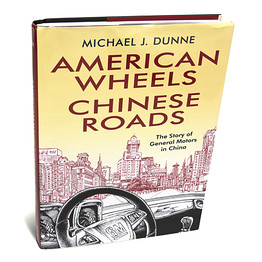 Despite the fact that GM had been losing market share for nearly 50 years and finally collapsed in to government guided bankruptcy in the United States in 2009, the company had become a major player in the auto industry in China. This is quite interesting, considering the fact that China is considered one of the most difficult car markets in the world. Between competing with the Chinese government and others, GM somehow emerged on top in a hostile and ultra competitive car market.
Despite the fact that GM had been losing market share for nearly 50 years and finally collapsed in to government guided bankruptcy in the United States in 2009, the company had become a major player in the auto industry in China. This is quite interesting, considering the fact that China is considered one of the most difficult car markets in the world. Between competing with the Chinese government and others, GM somehow emerged on top in a hostile and ultra competitive car market.
This book review from the WSJ of Dunne’s American Wheels Chinese Roads “deftly sketches the cast of characters…as consumers, corporations and cultures clash against an epic industrial backdrop.” Thanks to motivated local management, a very strong relationship between GM and SAIC, and numerous expensive engineering alterations, “GM Shanghai thrived.”
SAIC announced in 1995 that it would work with GM – thus the “50-50 partnership known as Shanghai GM was born.” There was also growing concern that Shanghai GM could lose market share to its across town rival, Ford. This risk was reconciled through GM’s “willingness to empower its Chinese partner” which was a key to their mutual success. The article does note that in Dunne’s final section he suggests that a day may arrive when SAIC leaves GM behind. He then notes that “Shortly after GM emerged from government-guided bankruptcy, the company, desperate for cash, sold 1% of Shanghai GM for a paltry $85 million…and ceded control of the joint venture to SAIC. Dunne notes that this forfeiture of leverage may mark the beginning of the end of GM’s success in China.
Contrary to Mr. Dunne’s pessimism, GM’s 2010 SEC filings display that there may still be hope for GM in China: as evidenced when Niedermeyer, editor of thetruthaboutcars.com, writes “Beyond the ludicrous $85 million fire-sale price was some much-needed reciprocity: a $400 million line of credit from Chinese banks, attained with the SAIC’s backing”. This financing served the purpose of rescuing its Korean Daewoo division – which is important to the company because it “supplies many of the products the company uses in China” and did not require US bailout money being shipped overseas. From a strategic standpoint, this is crucial in that GM reserves the right to a call option that would “regain a 50-50 parity in the partnership that brought the business such success”.
So the price of that 1% share was $485 million. Multiply by 50 gives a figure of roughly $25 billion as their share of the JV’s value (and hence Shanghai GM’s total value is $50 billion). Low? High? But certainly not trivial, and that’s net of modest rents / license fees paid to SAIC and GM, respectively.
Because of this, GM’s alliance with SAIC is likely to remain intact. But even if the alliance endures the future of GM’s success in China is still cloudy. In conclusion, if General Motors’ is to once again rise to its former position as a global leader in the auto-industry, its requires continued future success in Chinese markets.
I agree with Bloomer, that this “forfeiture of leverage” masks more important strategic considerations. Saving Daewoo was crucial to GMs continued success in China. It remains to be seen if changing consumer preferences have an impact on GMs partnership or sales in China.
As per data I showed in class, Shanghai GM is even stronger today, not weaker. For more on this – my attempt to calculate profits – see a post HERE on my auto industry blog, http://autosandeconomics.blogspot.com (150,000+ hits to date….small by the standards of “big” blogs but no longer trivial).